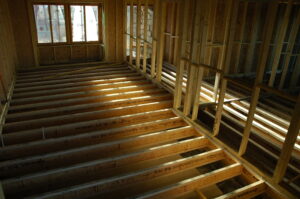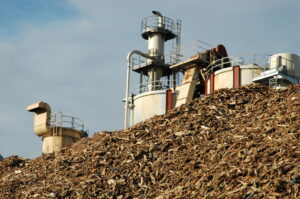Dan Ridley-Ellis and Marlene Cramer from Edinburgh Napier University answered five questions about the use of timber in the UK. Below you can read the short answers, but if you are more interested in the details, read the full blogpost here.
Q1) What is the proportion of timber buildings in the UK?
 For new house building, the use of timber frame is rising. In 2016 the market share was 28% and it has long been higher in Scotland (83%) than in England (23%). The market share for timber frame for new non-housing buildings is lower (11%).
For new house building, the use of timber frame is rising. In 2016 the market share was 28% and it has long been higher in Scotland (83%) than in England (23%). The market share for timber frame for new non-housing buildings is lower (11%).
Current housebuilding rates represent less than 1% of the total housing stock per year. The 2008 English housing survey reported that the vast majority of existing houses are of masonry wall construction. Only about 2.5% of the total housing stock at the time of the 2008 survey was timber frame. However, irrespective of the type of construction, most houses contain large amounts of wood in floors, internal walls and roofs.
—
National Statistics, “English Housing Survey 2015 to 2016”, 2017
National Statistics, “English Housing Survey 2008: housing stock report”, 2010
Q2) Which materials are currently used?
The dominant method for modern timber construction in the UK is light timber frame construction, which uses a very high proportion of wood-based panel products (particularly OSB, but also panels with high levels of recycled wood) and engineered wood products (particularly I-joists) . Most modern timber frame buildings use this in combination with traditional masonry cladding (see here for more info). Cross laminated timber (CLT) is gaining relevance in the construction sector for buildings that would otherwise have used concrete and steel.
The most common woods in modern timber construction are spruce, pine and fir. Most of the wood products are imported from Europe. Oak and Douglas-fir post and beam framing is still used for a small number of buildings. Larch is used but mostly in external cladding rather than structural timber. The UK has long been an importer of timber. The species used in the existing building stock (and where it came from) vary by age, depending on the UK’s trading and political history.
—
Sanna, F. “Timber modern methods of construction: a comparative study”, 2018
Hairstans, R. “Mass Timber – an introduction to solid laminate timber systems”, 2018
Forest Research, “Forestry Statistics 2018 – Origin of wood imports”, 2018
Q3) How is the market situation for recycled wood at the moment?
 The construction and demolition industry is the main source of waste in the UK. Roughly half of the wood waste generated in the UK results from either the construction sector (offcuts, support structures, overestimated purchase, site reject) or demolition of buildings. Each of these is as big a waste stream as packaging. Of the UK’s wood waste that is reused, about 60% is used for panel production (2008 figures) while the rest ends up as biomass energy source, agricultural products like animal bedding, or is exported. These industries are big enough that they can face wood waste shortage issues.
The construction and demolition industry is the main source of waste in the UK. Roughly half of the wood waste generated in the UK results from either the construction sector (offcuts, support structures, overestimated purchase, site reject) or demolition of buildings. Each of these is as big a waste stream as packaging. Of the UK’s wood waste that is reused, about 60% is used for panel production (2008 figures) while the rest ends up as biomass energy source, agricultural products like animal bedding, or is exported. These industries are big enough that they can face wood waste shortage issues.
Most of the treated wood and wood panels recovered from demolition sites end up as landfill or are used for thermal energy production. The good news is that the share of wood that terminates its life in landfill has been decreasing in the last years. This is partly still an effect of the economic crisis, but also partly caused by initiatives like “halving waste to landfill” and “Zero waste Scotland”. Many small scale projects exist to give waste wood a second life as valuable products like architectural salvage, furniture or art objects or to enable its direct reuse in the same function.
—
Wrap, Pöyry and Oxford Economics, “Wood Waste Market in the UK”, 2019
Wrap, “Waste wood end markets”
Wood Recyclers Association, “Export of waste wood products decrease as UK markets grow”, 2018
Q4) Is there a good reason for reusing renewable materials like timber?
Timber is highly valued as a sustainable and renewable resource. But as the demand for timber in construction is rising, we must not forget that renewable does not mean infinite and that sustainability does not just happen or is inherent to wood. We need to act as if wood is a limited resource, because – at any point in time – that is exactly what it is.
Using recovered wood as an additional resource will help to cover the rising demand, ensure a sustainable resource management and release the pressure for productivity on the forest. With the same goals in mind, the currently underused species and timber from undermanaged forests are also in the focus of InFutUReWood. At the moment, half of Great Britain’s softwood in forests is (non-native) Sitka spruce. Only 7% of timber harvested in the UK is hardwood and 84% of this is used for biomass fuel, even though a structural use might be possible. If grading methods for these wood species existed, they might become more relevant for the construction sector.
—
Egan Consulting, “CTI Policy Report: Value & Growth Mapping UK Timber Industries”, 2016.
Q5) Why do you want to change current grading standards?
First of all, no proper strength grading rules exist for recovered timber and it is not possible to just use the ones for new timber, since a lot of vital background information is needed to apply them. But we don’t usually have this information for recovered timber, and so we need to develop a grading method for the reuse of timber – one that is compatible with the system for new timber.
Secondly, even though spruce, pine, larch and other softwoods are growing in the UK, 84% of the sawn softwood used in construction in the UK is imported (2016 figure). A great proportion of the locally grown softwood is not used in construction due to misconceptions linked to the grading standards as well as over-specification of the required strength in design. By fuelling the discussion about grading standard and timber use practices, we hope to improve the understanding about grading amongst engineers and architects and so to remove the barriers for use of low graded timber.
Lastly, it is desirable to change conventional forestry management practices in the UK to more sustainable ones that fit better against the other roles that forests have (this opinion of the authors is outlined in the full blogpost). Silviculture practices have a great influence on the wood properties, so if you change them you might also need to update the grading rules. The same applies for changes in climate – temperature, wind and rain. Perhaps most pressing, the accelerating progress in tree breeding and improvement has the potential to change the relationships we assume for grading. We need to go back and look again at studies from decades ago. It seems not only the material flow should be circular, but also our work on improving the grading standards.
—
Egan Consulting, “CTI Policy Report: Value & Growth Mapping UK Timber Industries”, 2016.


